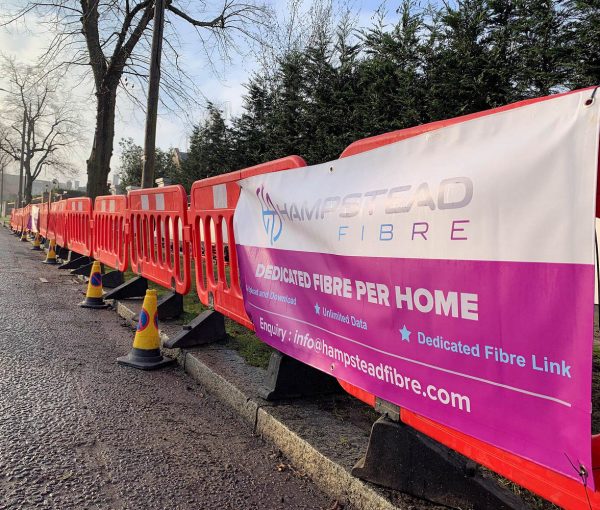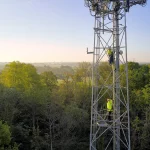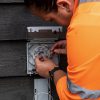Hampstead Fibre Build Premium FTTP Broadband in North London

Network builder and UK ISP Hampstead Fibre has today revealed the first details of their new rollout plan for a “premium” Fibre-to-the-Premises (FTTP) broadband service in parts of North London, which seems to be targeting wealthy homeowners and businesses who can afford something more akin to a leased line.
We first spotted the provider last September 2021 (here), but at the time they were still being established and merely spoke of their ambition to build a new “network initially in London and latterly in other locations across the UK.” London is the target of several aggressively competitive full fibre builds by Virgin Media (VMO2), Openreach (BT), G.Network, CommunityFibre and Hyperoptic, which makes it a difficult place for new entrants.
However, despite the challenges, Hampstead Fibre recently began their first civil engineering work around parts of North London’s N2 and N6 postcode areas, which is being supported by civil engineering firm VGC Group. The ongoing “pilot” build currently includes three roads around Hampstead Heath – The Bishops Avenue, Winnington Road and Compton Avenue (these are about half-way to completion).
Advertisement
A quick look reveals a number of interesting things about their pilot build. Firstly, there are currently no gigabit-capable broadband networks in this area and, secondly, you’d need to be fairly rich to be able to afford the local homes – some of which stretch into the tens of millions of pounds.
The provider is clearly conscious of the areas they’re targeting, which is aptly reflected by their planned service pricing (more on that later) and on the front page of their temporary website: “Connecting the world’s most sought after streets to the world’s most well-connected datacentres at the speed of light.”
The company’s founder, Dr Annie Yang, hails from a poorly served, if very affluent, part of North London herself and this is how the ISP was born (the capital city still has quite a few patches like this).
Dr Annie Yang, Director of Hampstead Fibre, told ISPreview.co.uk:
“Frankly I was extremely disappointed with the internet service … I was getting 0.5 Mbps upload, at which point it’s almost impossible to even have a video call. There’s no Virgin here, so the only other option would have been to get a leased line (which is very common around us), but I felt that this would be giving in and so Hampstead Fibre was born.”
However, in targeting such areas, the provider knew that it also needed to develop a much more premium product than the GPON based networks of shared capacity being deployed by others. As a result, their social media pages are promising to build a “DEDICATED FIBRE PER HOME“, which sounds more like a leased line style approach and indeed that is the intention.
Advertisement
“Our real competition is leased lines, to capture that market we need to be both cheaper than a leased line and offer a higher quality service,” said Dr Yang.”Everything we’ve built has been about quality, without regard for cost. The entire network is dedicated fibre to every home, not GPON where up to 128 houses are sharing bandwidth on one fibre. This means we’re deploying massive distribution cables, mostly 288 fibre cables.”
All of this will be supported by a dedicated fibre link to their primary point-of-presence in Telehouse North, as well as “full redundancy” to reduce the risk of outages. “We’re lighting these long-distance links with multiple 10G DWDM waves right now,” added Dr Yang, before remarking that it would be possible to then move up to multiples of 200G waves. Suffice to say, capacity does not seem to be a problem.
At launch, the ISP will be offering just two plans: 1Gbps for £100/month and 10Gbps for £500/month, which relatively speaking is not cheap, but then we doubt those in their pilot build area will be too concerned. The provider suggests that they could potentially even build a 100Gbps package for homes, but obviously there’s not much point in that while most computers, internet services and end-user devices cannot fully harness it.
In fairness though, we have seen regular ISPs that still charge around the £100 mark for 1Gbps (County Broadband, Ecom, Jurassic Fibre, GoFibre etc.), although most of those are focused on rural areas and thus have more challenging economics to consider (note: some homes in Hampstead Fibre’s patch are over 25 metres apart). But such expensive plans are becoming less common, with 1Gbps now typically in the £50-£70 region or less.
Advertisement
At the end of the day, we like that Hampstead Fibre is trying a different approach from other ISPs by focusing on quality and performance over affordability. We hope they succeed in that, although much will depend upon whether the level of take-up is sufficient to fuel future growth. Assuming the pilot goes well, then we expect to see them expanding into the Hampstead Garden Suburb and other areas.
Mark is a professional technology writer, IT consultant and computer engineer from Dorset (England), he also founded ISPreview in 1999 and enjoys analysing the latest telecoms and broadband developments. Find me on X (Twitter), Mastodon, Facebook, BlueSky, Threads.net and Linkedin.
« Scotland Start Open Market Review for Gigabit Broadband Rollout
Full Fibre UK ISP toob Keeps Gigabit Broadband Prices Frozen »






















































The prices are sort of irrelevant anyway, considering the target market will likely have numerous ways of having their companies pick the tab up in the most tax efficient way.
If Hampstead Fibre can offer a gigabit service with path resilience for that sort of cash they deserve to do well.
Very nice set of PR but not sure how this is actually better..
I don’t know of any providers in the UK using a 1:128 split on GPON, Openreach, CityFibre etc are all on 1:32 max, and that assumes high take-up to reach it. CityFibre state they build their access network as rings so they have two paths to their exchanges, whereas this just has a single path to their undisclosed local exchange (I hope it is not a rack in a BT exchange)? Lots of providers are now using XGS-PON too.
288 Fibre is not a massive distribution fibre, this is what most people are deploying for their distribution.
And 10GEs back to Telehouse, whilst offering 10GE to the end customer? Probably OK as unlikely to want a single thread at 10G. Other providers have spoken about their 100GE based networks with 800G wavelengths already.
So different approach yes (though there are several others out there using this approach rather than PON already), better quality/performance I’m not convinced.
I think all your doubts/questions have answers in the article already to be honest. But happy to illustrate a bit more here :
1. we are not using BT exchanges
2. it’s not just 10G. It’s currently 8x10G wavelengths for 80G in total and this is only to server a lower hundreds of homes as a pilot programme. Deploying more bandwidth is as simple as lighting additional wavelengths on the same fibre and we’ll deploy as much as is required to ensure zero congestion.
3. our network is fully redundant with equal cost multipathing
4. we are using 288f passing people’s homes. With a 32:1 split, a 48F cable can server 1,500 homes. Our 288F fibre can only serve 288 homes
Hope this helps 🙂
Thank you and best regards,
Annie
@Annie – Is there any reason why you aren’t using 100G in your backhaul?
Anon is correct about the single thread issue if you are selling 10GE services with Nx10GE backhaul.
From memory B4RN, Grain and Gigaclear also use separate fibres per customer in their aggregation network.
Annie, from your write up I’m guessing you’re targetting business customers with high bandwidth requirements, as 10G is a massive overkill for a household. The only types of customers, I can think of, who require 10G bandwidth might be medium size server farms exchanging large amounts of Video/Voip data over the cloud. Even 1 GB/s is overkill for most users, which is why a 1:32 ratio is deemed suitable for GPON.
I’m curious, does the 288 Fibre terminate in rented rack space, within a Datacenter, using your own access routers with rented backhaul into the Datacenter cloud router/switches? What’s the ballpark operating costs for such a small scale operation.
@Ex Telecom Engineer
“I’m guessing you’re targetting business customers with high bandwidth requirements, as 10G is a massive overkill for a household”
If you’re driving around London and taking your kids to school, do you really need a 600hp, £200k SUV capable of reaching 150mph? No. But if you live in certain areas and are part of a certain social class, you buy it anyway both as a status symbol and because you want to buy “the most expensive” thing regardless.
I think this ISP is targeting the same kind of people with the internet equivalent of a 600hp SUV.
@David – we’re not likely to ever use 100G-LR4, as you can only fit one of these in a fibre pair (32x10G would give more bandwidth). We’d use multiple 200G waves with coherent optics (you can fit 96 of those on a fibre pair for 19.2 Tbps). These are very environmentally sensitive, they’re not currently available with industrial temperature range required for cabinets, so some research is required before we can deploy this.
there’s no singe-thread issue as we use L4 ECMP, so one customers traffic will take multiple routes, a different route for every TCP connection. this means we could serve a 100G customer using 32x10G links if we wanted.
B4RN, etc do also use a dedicated fibre per home, but as far as we understand the tradeoffs are different in rural areas.
@Ex Telecom Engineer – we’re targeting households. The 10G option is for those who want to be able to download a 4K movie in under 15 seconds, if people want the best you can get then it’s available, if not then go for 1G.
our 288F terminates in street cabinets then the traffic makes its way towards Telehouse etc through our core network.
Hope this helps. 🙂
Thank you and best regards,
Annie
@annie – B4RN lays dual fibres to each property. For current 1Gbs and 10Gbs services only one fibre is used with BiDi optics. In the future when we start offering 100Gbs and upwards we would use both fibres. For rural deployments duct space is not really the issue as everything needs new digs anyway. Also with sparse properties a 288f supporting 144 drops goes a very long way!
Alt nets deliver service in many different ways, ring architecture is an obvious choice but not sure there really is an argument around who does what best. Investment drives some choices around delivery method. Likewise bandwidth availability being overkill is a well worn statement, if a customer is happy to pay for something “premium” like an expensive Rolex watch over cheap casio that both do the same thing then that is choice i guess.
Looking at where you might see issues and how your provider has addressed these is always good, as you say different companies have used different approach so are affected differently.
Looks like straight fibre here so no protection on fibre cut locally? Some altnets use rings, Openreach goes a long way on FTTH with straight fibre.
Local cabinets, shorter distance of unprotected fibre, but enviromentals a challenge though looks like they are aware of this so hopefully designed correctly. One altnet proudly published images of a new cabinet, south facing against a wall with Data Centre spec kit and no cooling.
Local cabinets vs. dedicated exchange – environmentals as above, but power is your biggest enemy, cabinet will likely have one power feed and batteries, the exchange two with batteries and generators, so bigger risk here being in a cabinet. Also siting a challenge cars love to hit cabinets.
So for me risk on fibre cuts locally and also on power to cabinet, so not sure it wins vs. PON on a ring topology going to an exchange that has resilient power.